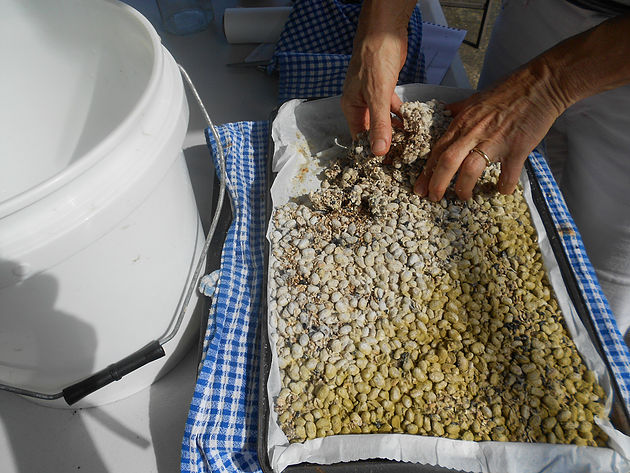- Posted on
- Elisabeth Fekonia
- No Comments
Home Made Soy Sauce
You will need these utensils:
- Heavy frying pan or griller
- A very large saucepan
- Incubator set at 30ºC
- Thermometer
- Tray
Before the soy sauce can be made, we need to make a Shoyu Koji Sauce
- 7 cups of soy beans
- 6 ½ cups whole wheat berries
- 2 teaspoons starter
- 3 ½ cups sea salt
- 1 gallon (4.5 litres) rain water

Late afternoon:
Rinse 7 cups of soya beans and set them to soak, well covered with water for 12- 16 hours.
Early the next morning:
Drain the soy beans and boil them about 5- 6 hours. The soya beans should be soft enough to crush between the little finger and thumb.
Preparing the wheat:
Hard wheat may be used but soft wheat gives a better flavour. Stir whole wheat briskly over high heat in a heavy frying pan until golden brown. Slight charring is desirable to develop flavour. Grind the wheat very coarsely to break each kernel into 4- 5 pieces, otherwise bulghur may be used instead. If you chose bulghur, sanitize it by browning in a heavy frying pan.
Inoculating the Koji:
Drain the cooked soy beans several minutes and toss them into a large bowl with the roasted, cracked wheat, mix thoroughly and cool to body temperature. Sprinkle the starter over the cooled mixture and mix in very thoroughly. Transfer the mixture into a tray and fill no more than 2 inches deep. Make furrows into the mixture to increase the surface area and reducing any hot spots as the mould will soon develop its own heat. Place a thermometer into the koji and cover with a tea towel and some plastic wrap to seal in the moisture. Incubate at 32ºC.
Throughout the day:
Check the koji temperature every 4 hours to see that the temperature remains between 27- 35ºC. It should not register above 40ºC for very long as this temperature will kill the mould spores and the koji won’t work. Stir the koji each time you check it and replacing the furrows in the tray.
After 2 to 2 ½ days the koji will be covered by the mould and appear cottony white with possible patches of yellow- green which is the natural colour of mature koji producing spores (If there are black, very dark green or shiny sticky spots appearing, either cut them away or if too much, discard the koji.)
Mixing the Moromi: (Mash)
In a 2 gallon (8- 10 litre) bucket add the soya bean mixture with 1 gallon (4.5 litre) of rain water and the 3 ½ cups of salt. Stir until the salt has dissolved then stir in the koji. Cover the bin with a close fitting lid and stir daily for 1 week. Place the bin at a stable temperature of 25ºC. Label and date the shoyu sauce and stir once a week for 12 months.
When fermentation is complete:
Transfer the finished moromi to a press sack, twist and press. Add some flour and molasses to the solids and ferment again for several months for a second batch.
Go to G.E.M. cultures for the shoyu sauce koji.
